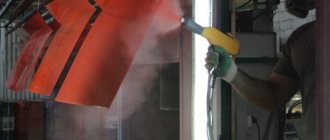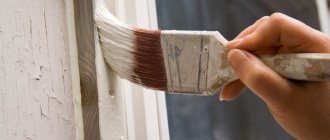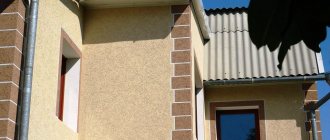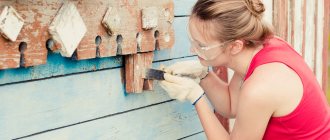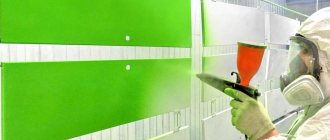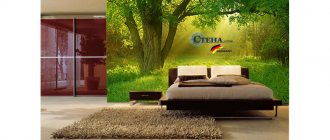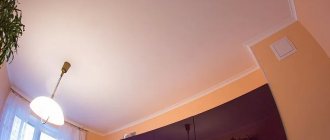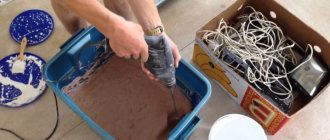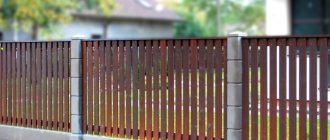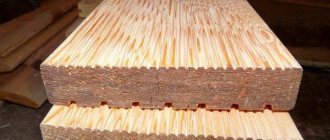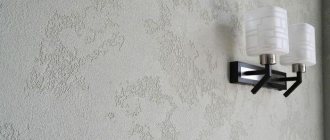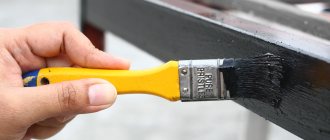Why do you need to paint the bark beetle?
Plastered profile in white or light gray. But after drying, the surface can be given a colorful look. Painting serves not only for additional decoration, but also to extend the life of the plaster.
Painting serves not only for additional decoration, but also to extend the life of the plaster.
Advantages and disadvantages of painting
When applying a paint coating, the finish receives the following advantages:
- dirt-repellent effect;
- the ability to absorb and release moisture (hygroscopicity);
- with temperature changes, the plaster layer will be less susceptible to delamination.
The decorative effect of the exterior and interior is created not only by one paint, but by two or more.
The decorative effect of the interior is created not only by one paint, but by two or more
When choosing a “bark beetle” finish texture with subsequent painting, you need to take into account some disadvantages:
- in case of mechanical damage, it is difficult to restore the plaster pattern and color;
- when working outside, the work process is affected by weather conditions;
- If the technology is violated, the paintwork will peel off or lie unevenly on the surface.
If application standards are followed, the coating will last a long time without losing its original color.
You should not buy cheap paint from unverified manufacturers. Such material will quickly lose its original appearance.
Types of paint for bark beetle
There is no special coating for the “bark beetle” texture. The working material is selected depending on where the repair will take place. Bark beetle paint for facade and interior work is used depending on its purpose. And how to paint this or that surface is up to everyone to decide for themselves.
Oily
Oil paint is the most popular, as it has a wide range of uses and is inexpensive. It can be used to paint any materials, including bark beetle plaster.
The viscosity of the dye is given by drying oil, which is now produced synthetically. Mineral flour is added to the suspension as a filler, and inorganic pigments give the paint the desired color. Using a solvent, the required consistency of the composition is obtained.
Oil paint can be used to paint any materials, including bark beetles.
Oil dyes are distinguished by rich colors and shades, but have disadvantages:
- low moisture exchange prevents the evaporation of moisture from building materials;
- react with alkalis;
- low fire resistance;
- unpleasant odor, toxic to humans;
- Over time, the paint fades and loses its shine.
Due to its shortcomings, this “outdated” paint has been replaced by more modern options.
Acrylic
The paint is based on polymers of acid esters. When diluted, it can be tinted with aqueous pastes containing pigments, but after drying it becomes waterproof. This paint has a lot of positive qualities:
- durability;
- wide color palette;
- vapor permeability.
May be toxic when applied. Used in painting and by painting specialists.
Acrylic paint is based on polymers of acid esters
Textured
It is a viscous dense mass based on acrylic and polymer components. Fillers can be sand, granite and marble chips, crushed gas silicate and polymer fibers. A very unusual paint in texture: it imitates wood worn away by insects. Suitable for indoor and outdoor work, characterized by:
- durability;
- vapor permeability;
- frost resistance.
This finishing material is used as paint and putty at the same time. Hides surface cracks and other imperfections.
Disadvantages include high cost and material consumption. And the master will need skill when working.
Textured paint is used as paint and putty at the same time
Alkyd
A widely used paint and varnish material based on synthetic alkyd resins. It includes:
- film formers (glyphthalic and pentaphthalic);
- solvents (white spirit, toluene, solvent);
- fillers (marble or lime chips, silicates and other minerals);
- additives (driers, plasticizers, stabilizers)
With its low price, durability, vapor permeability and resistance to temperature changes, it has a long-lasting unpleasant odor, which is why it is used more often for facade work.
Widely used paint and varnish material based on synthetic alkyd resins
Structural
It is also called textured. It can be used to paint a surface that is not perfectly level, as its texture can hide many imperfections. Over time, the color will not lose its original appearance. After drying, a film is formed that will extend the service life of the coating.
It differs from conventional paint in consistency, appearance, and high cost. Its synthetic fibers, quartz sand, stone chips and other additives create texture on the surface.
The painted surface imitates crocodile skin, marble, velvet, wood. This property allows you to experiment and create new drawings. Apply to any surface with different textures and textures.
Structural paint can be used to paint a surface that is not perfectly level, as its texture can hide many imperfections
Silicate
The binder of the composition is glass, thanks to which dust does not stick to the paint. In addition, the mixture sometimes includes fine silicon powder, zinc, and aluminum, which gives the consistency anti-corrosion properties. This dye also contains crushed minerals that are resistant to alkalis. The paintwork received its name due to the presence of sodium and potassium silicates in it.
The service life of the coating is at least 20 years, and all these years it looks like new. The loose structure of the paint allows moisture to evaporate freely. It is fireproof, resistant to UV radiation, temperature changes, and has a matte texture. Painted surfaces are not susceptible to the growth of mold and other microorganisms.
But there are also disadvantages to this texture:
- lack of elasticity does not fill small cracks;
- due to high toxicity, you should work in personal protective equipment;
- if necessary, it will not be possible to remove it, since its high strength will not allow this.
Mainly used for facade decoration.
In silicate paint, the binder of the composition is glass, thanks to which dust does not stick to the paint
Mineral
This paint contains crushed minerals that serve as pigment. It is sold in powder form, which is diluted with water to the desired consistency before use. Mineral mixtures have many advantages:
- are an environmentally friendly product;
- have vapor permeability;
- resistant to frost and high temperatures;
- with the introduction of synthetic resins, adhesion, hiding power, water resistance, ductility and resistance to particle settling increase.
In turn, mineral dyes are divided into:
- limestone;
- cement;
- silicate;
- oil
When dry, the composition becomes very durable.
Mineral paint contains crushed minerals that serve as pigments.
Silicone
A painting product containing resins and an emulsion of water. The paint is environmentally friendly in any condition and can be applied even in rooms with high humidity, as its water-repellent property allows it. Odorless, universal for all surfaces. Combines the advantages of acrylic and silicate paints.
Due to its elasticity, the dye will fill any gap. Dust does not stick to it and dirt is easily removed.
Very durable, service life reaches 20-25 years.
Silicone paint contains resins and an emulsion of water
Which paint to choose?
It is the last point, which relates to the advantages of decorative bark beetle plaster, that can be considered the most significant when it comes to creating an individual interior.
On a note! It should be understood that there is no special bark beetle paint designed specifically for such work. Therefore, you need to focus on available materials.
Preference should be given to the most common options.
Oily
This suspension allows you to create a very bright and rich surface. But there are also numerous disadvantages. Among them are especially distinguished:
- Almost complete absence of vapor permeability.
- Fear of exposure to alkaline substances.
- Low fire resistance.
In principle, this option is considered outdated for this type of work. Therefore, it is preferable to give preference to more modern formulations.
Oil paint allows you to create a bright finish
Alkyd
An excellent composition, but it is best used for work carried out outdoors. The reason for this is simple: this mixture has a very specific smell, which can erode (indoors) for many years. But there are also advantages:
- Low price.
- Neutrality to temperature and humidity.
Alkyd paint has a specific smell
Acrylic
Many specialists who professionally paint bark beetle plaster prefer this particular suspension. She deserves this treatment for the following reasons:
- Environmentally friendly. The mixture is completely safe.
- The components included in the composition, namely acrylates, make the coating strong and very durable.
- Variety of color shades. There is a lot of scope for the manifestation of imagination.
- Vapor permeability. That is, the wall will breathe and the structure of the coating will not be disturbed.
Acrylic paint is the safest to use.
We can conclude that this material is truly the optimal solution.
Recommendations for choosing colors
Repair is always difficult: choosing a design, interior, finishing material. Designers are trying to create new compositions. But the implementation of an idea does not always become comfortable. Any master wants to make sure that after the renovation is completed, everything looks organic and fits into the overall architecture and interior.
Paintwork paints on sale are already available in colored or basic white, to which color is gradually added until the desired shade is obtained. An important rule when choosing a tone for painting walls in a room is the combination of shades. If the furniture is made in restrained colors, then it is recommended to paint the walls in more saturated colors, and vice versa. We must not forget the principle of combining warm and cold shades: warm ones should be combined with warm ones, and cold ones with cold ones.
If you study color effects, you can visually expand, lengthen the room or bring the walls closer. The perception of the interior is influenced by the location of the room relative to the cardinal direction (north, south). On the south side, the room can be painted in dark colors, but on the north side, only light colors will do.
An important rule when choosing a tone for painting walls in a room is the combination of shades
Consumption of paint and varnish material
Before purchasing paintwork, you should measure the coverage area, the number of layers applied, record the data in a work notebook and, when purchasing, carefully read the instructions on the package.
When making mathematical calculations, they buy paint not exactly with the numbers displayed, but more, which will be about 10%, because during repairs nuances arise where the consumption of paint and varnish material may exceed the calculations.
Before purchasing paintwork, you should measure the coverage area
What primer to use
Before painting, the plastered surface should be primed. The subsequent result depends on how correctly the composition is chosen and the technology is performed. There are three types of primers used for painting:
- adhesive;
- deep penetration;
- universal.
Each of them has its own purpose, and when choosing a primer, this must be taken into account.
Before painting, the plastered surface should be primed
Adhesive
This composition ensures good adhesion of the paint to the putty. An abrasive material in the form of quartz sand or needle quartz and water-based glue are added to the composition. The surface becomes rough, like sandpaper.
Deep penetration soil
The soil consists of 80% water, acrylic resins, polymers. Additional substances (antiseptic, silicone substances, latex) give the suspension new properties.
This soil is capable of penetrating up to 10 cm, binding dust residues and strengthening the surface. Pores form on its surface, which help absorb moisture up to 70% inside, and only 30% evaporates into the air.
Once dry, a protective film forms, providing the paint with protection against mildew and creating the basis for good interaction.
This soil is capable of penetrating up to 10 cm, binding dust residues and strengthening the surface.
Universal
Universal formulations contain a minimum content of active ingredients. This is basically an acrylic primer, it dries quickly and is in demand by craftsmen because of its affordable price and good quality. It is used if there is no urgent need to buy expensive and better quality.
Any soil dries out in 4-12 hours.
Which paint to choose
Painting bark beetle plaster can be done with different types of paint and varnish material. It is important that the chosen option has good resistance to natural influences. The facade is constantly exposed to various negative influences, and in order for the painted layer to look good, you should not skimp, otherwise you will have to repaint it very soon. On the construction market you can find many types of suitable paints for this purpose, to make it easier to make a choice, the most popular and high-quality types will be considered.
Oily
The oil type of paint was popular earlier, when the range of products was not as wide; recently, masters have abandoned this type, the reason being the disadvantages that oil paint has:
- Strong smell;
- Long drying time;
- Poor level of air transmission;
- Does not withstand exposure to alkalis;
- Low level of fire resistance.
Alkyd
Alkyd enamels are distinguished by reasonable cost, good resistance to moisture and other factors that negatively affect the coating. It is important to understand that the product emits a pungent odor; if interior work is to be done, it is better to avoid alkyd paint. The smell will linger in the apartment for a long time. Suitable for working on facades. Here, a separate primer, enamel, is used for bark beetle rust, which protects the metal from corrosion.
Acrylic
Acrylic bark beetle enamel primer is the optimal choice for painting. For this coloring, products with an acrylic base are excellent; they have a number of advantages:
- Eco-friendly composition;
- Creates a strong and durable layer;
- A large number of color solutions, with the help of color you can achieve any shade;
- Vapor permeable property at a high level.
- Acceptable price.
Bark beetle painting technology
There are various technologies for decorative plaster with a “bark beetle” structure: rain, carpet, lamb, geometry. Painting methods also vary.
Preparatory work and tools
To apply paint or primer, you need to prepare the workplace:
- remove everything unnecessary;
- cover furniture and floors with film;
Before painting, it is necessary to cover the furniture and floors with film.
Prepare auxiliary items and tools:
- primer/paint tray;
- roller, brush and sponge;
- bucket for mixing dry mixture;
- drill with attachment;
- painting spatulas (10 and 30 cm);
- spray bottle and water;
- plastic grout for the bark beetle.
After everything is prepared, you can start working.
To apply paint or primer, you need to prepare the necessary items
Applying paint to the wall
Beginners need to know that coloring is a labor-intensive process. Sometimes painting takes more time and effort than the plaster itself. This is due to the complexity of the relief, due to which the paint is distributed unevenly.
But there is absolutely no need to rush when painting. Before painting, you need to choose a tool. For small volumes take a brush and roller. For a large area, you can use a paint sprayer, but often during operation it distributes the liquid incorrectly, becomes clogged and stops spraying. This can ruin the entire workflow. If you have a compressor, it is better to use it.
If the surface was previously painted with water-based paint and subsequent work will be with the same material, then the old paint does not need to be washed off, but the wall will still have to be primed first.
For small amounts of painting, use a brush and roller
Painting the bark beetle in two colors
If you limit yourself to one color, the result will be ordinary. To make the color interesting, you can use a two-color pigment:
- Use a brush to paint the recesses with one color and let dry.
- Then apply a layer of paint on the outside, which also differs in shade from the original coating.
In the second case, they work with a roller, making movements from top to bottom smoothly without pressure, so that the paint does not flow into the recesses.
Not everyone succeeds in painting the “bark beetle” in two colors; if it doesn’t work out, then it’s better to hire a professional painter.
To make the color interesting, you can use a two-color pigment
Review and characteristics of the compositions
What paint should I use for decorative bark beetle plaster? First of all, it is necessary to select a material that provides vapor permeability and creates protection against the formation of fungus and mold on the walls.
Let's look at a few main types.
Oil
It has zero vapor permeability, quickly loses its original shade, peels off, does not withstand alkaline environments, supports combustion, and has a small color palette.
Even low prices do not add attractiveness to such a material - oil compositions are used to paint fences or walls of technical structures in order to create a protective film on the surface of the materials from exposure to water.
Such compositions are considered the oldest and cheapest; they are used for painting various surfaces; they are not used on external insulated walls.
Alkyd enamel
The paints are produced on the basis of pentaphthalic or glypthal varnish and differ in the following characteristics:
- low vapor permeability;
- resistance to ultraviolet light and temperature changes;
- ability to withstand chemical environments;
- long operational period (up to seven years);
- reasonable cost;
- limited palette of shades (no more than twenty-four tones);
- high level of flammability.
A solvent is added to alkyd compositions, which creates an unpleasant odor that disappears during the drying process.
In bright sunlight or hot summer, if the outer wall is painted in a rich shade, this smell appears again.
Acrylic based
This material option is considered the safest from an environmental point of view. It is almost odorless, perfectly breathable, resists low temperatures and ultraviolet radiation, lasts for at least ten years, and has a wide range of colors.
If you are deciding what to paint your outdoor walls with, there is no better option.
Various options for painting the facade of the house
Structural plaster will not only decorate the exterior, but also protect the walls from external factors. Here are a few examples showing how to paint the “bark beetle” on the facade of a house.
Classic painting method
After choosing a dye, the color of which should be in harmony with the roof and the overall design, begin painting:
| 1. To make the paint look uniform, use a primer tinted to match the color of the main paint. | |
| 2. For small surfaces they work with a roller, brush and sponge, for large volumes - with a compressor and spray gun. | |
| 3. To apply the first layer, mix thick paint and start working with the recesses. | |
| 4. Drips that arise during work are carefully removed with a sponge. | |
| 5. After the first layer has completely dried, apply the second. This time the paint is diluted a little thinner. |
To achieve an additional color effect, the raised areas are treated with plastic grout.
The bark beetle combines well with wooden coverings and lining.
Initial tinting of the paint mixture
This method is suitable for those who have no experience at all. The color is added to the plaster, and after drying the wall looks already painted. You can leave it like this, but it’s better to cover it on top with the same shade or a tone darker or lighter, then the work will look complete.
The color is added at the mixing stage. In this case, the mixture is prepared all at once, otherwise a uniform tone will not be obtained. After completing the work, you need to leave it to dry for two days.
Double coloring
Double painting involves applying the composition in two layers, which allows you to treat both the recesses and the outer layer. First, paint the recesses with thick paint with a brush, and remove any smudges with a sponge. After drying, apply the top layer with a diluted substance using a roller.
Double coloring of the bark beetle
Using primer
You can add color to the primer and go over the surface in several layers, each time letting the previous layer dry.
With this coloring, the color will not be very saturated, but still attractive.
Advice from experts on painting decorative plaster with a non-uniform texture
Experts recommend painting the bark beetle both indoors and on the facade if certain conditions are met:
- at a temperature of at least +5 ºС;
- do the next coating only after the previous layer has completely dried;
- use a primer not of simple content, but with adhesive properties;
- pre-prime the work surface at least twice;
- dilute dry mixtures following the exact instructions on the package;
- use material only from trusted manufacturers;
- entrust the combination of shades to a professional or a color wheel that is available on the Internet;
- A shaker will help to mix the color with plaster or paint; it can be found in construction stores;
- Before the main painting, test the composition on a small area in an inconspicuous place to see the final result.
If the technology is not followed, the result will be of poor quality.
It is better to entrust the combination of shades to a professional or a color wheel that is available on the Internet
What else do you need to know
There are a number of recommendations that provide the most correct preparation and simplify the work itself. So:
- To get a surface that will be distinguished by its individuality, but reduce labor costs, do the following: initially add the desired color to the mixture, which echoes the color of the paint.
- When choosing a material in a store, pay attention to the manufacturer and the availability of the necessary certificates. It should be understood that the market is flooded with fakes. After applying them to the wall, many problems appear. Sometimes it comes to the point where you have to completely remove the textured layer.
- You need to wait for the plaster to dry completely. It often happens that you want to finish work faster. The result of such haste is stains, swollen and destroyed areas.
By following technology, you can achieve an amazing effect. For greater convenience, use the following tools:
- A roller with medium pile (short - it produces an excellent effect, but you need experience).
- Set of brushes: wide and small.
- A sponge, or better yet a mitten.
On a note! A roller with a long pile covers the wall perfectly, making it possible to treat large areas at once. But a lot of compound accumulates in the recesses, it takes a very long time and dries poorly, cracks and swelling appear.
Painting plaster with a roller
Possible difficulties
Difficulties often arise in the process of work, the cause of which cannot always be recognized:
- A short-haired roller will not be able to cover all the indentations, and the surface will look untidy.
- If you use a roller with a nap longer than 1 cm, the paint will run off heavily, making your work slower and more difficult.
- Saving on primer and paint will negate all the work.
- The desire of a non-specialist to paint a surface with expensive paint or several shades can lead to disastrous results. Therefore, the choice of coloring composition must be considered by comparing the desired result with your capabilities.
“Bark beetle” is a structural decorative plaster that will not only decorate, but also protect walls from external factors. And to make it look aesthetically pleasing and reliable, it can be painted using one of the above methods. Before making a final decision, you should weigh the pros and cons and only then start painting the house yourself.
Have you ever had to paint the bark beetle yourself? Share your life hacks in the comments.
Why do you need to paint?
Painting decorative bark beetle plaster is not the only solution, because the color scheme can be created in several other ways: by adding color to the plaster solution, applying a layer of wax or varnish.
But only paint provides some advantages:
- gives uniqueness to the interior, allows you to create unusual design solutions;
- creates additional protection for plaster;
- helps to zone a room without using other materials.
